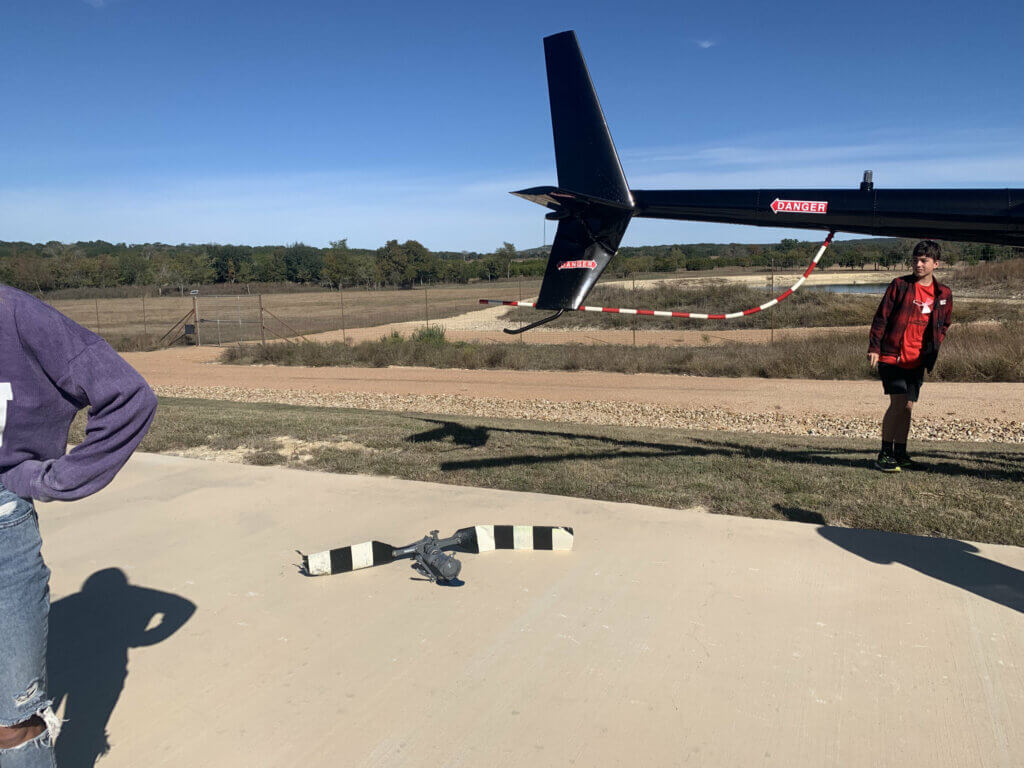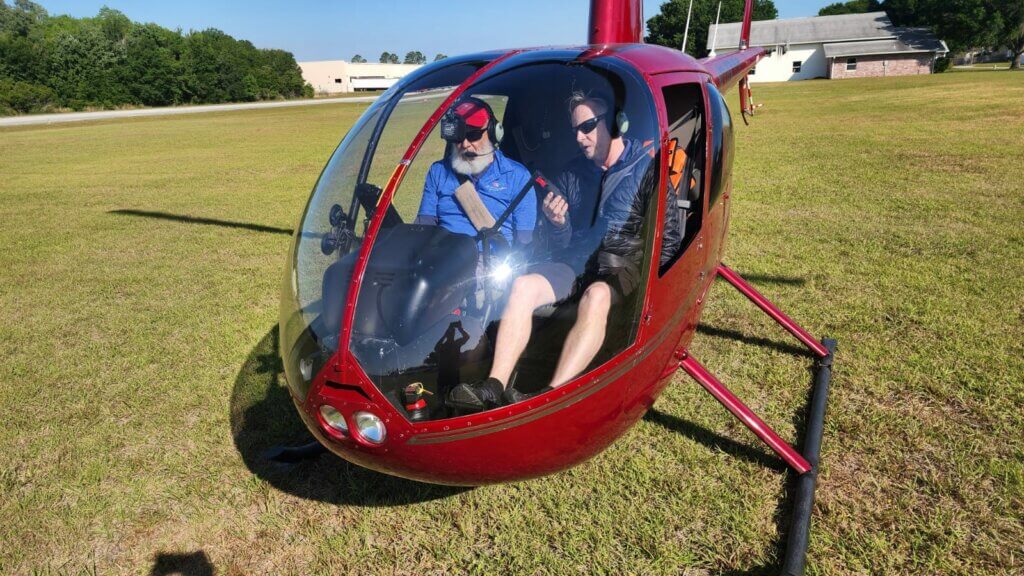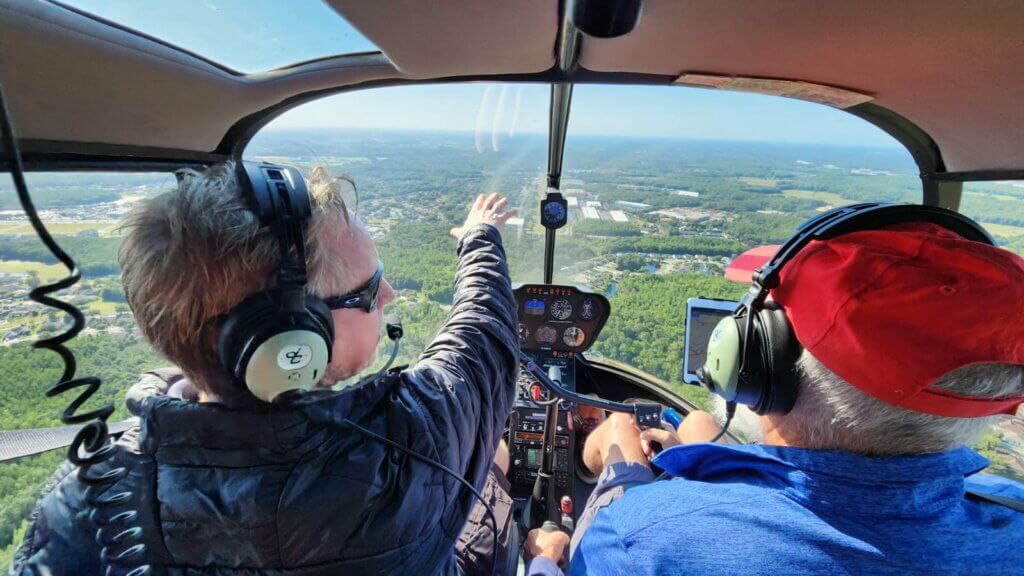On November 13, 2022, Doug Anderson planned to take his girlfriend and his daughter for a flight in his Robinson R44 Raven II. He pulled the aircraft out of his hangar on his private ranch in Blanco, Texas, completed a thorough pre-flight, and started the engine.
Anderson lifted the helicopter into a 10-foot hover and made a pedal turn into the wind, preparing to take off. A second later he heard a metallic pop.
“I had just enough time to ask my girlfriend if she heard that when the aircraft started shuttering, then the tail suddenly dipped and the helicopter started a hard spin to the right,” Anderson recalls.
Anderson’s training kicked in automatically. He rolled off the throttle and entered a hovering autorotation. He kept the aircraft level and maintained control until the aircraft settled. While it skidded a bit, it landed upright with no significant damage from the landing. Everyone onboard was unharmed.
“After we shut down, I looked around and everything looked fine; there was no way I hit anything on that wide open ramp,” he said. “Then I saw my tail rotor was missing. It was 50 feet away from the aircraft.”

The next thing Anderson did was call Simon Jones, the recurrent training flight instructor in Southern California he flies with every six months for advanced recurrent training.
“I just said, ‘Hey man, I want to thank you. Today you probably saved my life,’ ” Anderson recalled. “When he was out here last, he told me the chances of losing a tail rotor are really, really slim, but he was going to teach me what to do just in case. Had we not practiced that, I would not have known what to do and I could have seriously hurt or killed myself or my passengers.”
When he looked closer, Anderson found feathers and blood where the tail rotor was, on the ground, and with the tail rotor in the grass. The cause was clearly a bird strike. An animal conservation specialist later inspected the few pieces of the bird he could find and determined the culprit was most likely a kite, and not a very large one at that.
“Simon said this was only the second time they’d ever heard of a bird taking out a tail rotor,” Anderson said. “And I am so lucky Simon gave me the training to respond. That was nothing my initial flight instructor ever demonstrated or even taught.”
Advanced Flight Training on Demand
Jones, 53, has spent his entire 30-year helicopter career flying Robinson helicopters, with the vast majority of that time performing flight instruction. A British citizen, he was working for American Airlines in Manchester, England, when the aviation bug bit him in the early 1990s.
Jones first earned his airplane rating in Texas then began helicopter flight training in California in 1994. When his student visa ran out, he invested with a partner in an R44 to gain an E-2 nonimmigrant visa and continue his flying career in California. After a few years of commercial operations and instruction, Jones moved into teaching more advanced emergency procedures. In 2003, he began contracting with Robinson Helicopter Company as one of the flight instructors during the Robinson Pilot Safety Course.

In 2005, Jones founded Advanced Flight at Torrance Airport, down the field from Robinson Helicopter Company, with his own R44 helicopter to specialize in advanced flight instruction. The maneuvers he teaches build on basic instruction, but include actual training in scenarios most flight schools can’t or won’t teach, including full touchdown autorotations, stuck pedal, zero airspeed autorotations, power on autorotations, lost tail rotor, hydraulics failures, vortex ring state identification and recovery, and more.
“Most of my customers already knew how to fly,” Jones explained of the early days with Advanced Flight. “They would come to the Robinson factory for the pilot course, where they’d only do about an hour or so of flying. Then they’d come down to my company to do more advanced or enhanced emergency procedures.”
Between flying at Robinson during courses and providing advanced instruction, Jones began to develop a reputation in the Robinson community as a highly skilled, down-to-earth instructor who put students at ease as he taught them the advanced skills they hadn’t learned elsewhere. He also built a hefty student list of customers from around the world.
“Over the years, I got to know a lot of clients who, for insurance purposes, were required to attend the safety course or get advanced instruction every year — and that got expensive for them in terms of costs for the course, travel, hotel, and missed work,” he explained. “A lot of them were business owners and that was a real pain. They started asking me if I could come to them. We would work with their insurance companies to get permission for them to satisfy recurrency requirements with me. I could fly out to them on a Friday, fly with them Saturday and Sunday and fly home Sunday night. They wouldn’t miss any work. Slowly but surely my business evolved into a purely consultation and traveling instructor pilot service.”
Today, Jones has close to 17,000 hours of flight time with the vast majority being hours of instruction given. He travels multiple times a month domestically and internationally to conduct advanced instruction in the R44 and R66. While he no longer owns an R44, when there is a request for advanced training in Torrance, he has agreements with a local flight school to contract its helicopter for the training.
A Higher Level of Safety
Federal Aviation Administration regulations require pilots to undergo a biannual flight review every two years to remain current. Insurance companies often require recurrent training more often, especially for private owners. Anderson, who sold his R44 and how owns an R66, insists on having that training every six months, emphasizing his safety focus.
“I never went the commercial route, but I want to operate with the professionalism of a commercial pilot,” Anderson said. “I have about 1,500 hours in helicopters and I’m only now feeling like I know what I thought I knew at 400 hours. You have to respect the helicopter. Every time I start to feel too comfortable, I call Simon and tell him it’s time for him to come out and shake me up again. You can’t be too proficient.”

Rob Rawlings flies a Robinson R44 Raven I for Vertical Flight in Clearwater, Florida. In addition to tours, the company does a great deal of commercial photography and aerial survey work, which can put the helicopter into some sticky situations if an emergency were to occur.
A former U.S. Army Black Hawk pilot and instructor pilot for the U.S. Coast Guard, Rawlings is by all accounts a very skilled helicopter pilot. When he started at Vertical Flight four-and-a-half years ago, his first mission was to attend the Robinson Pilot Safety Course. That is where he met Jones. After the course, he signed up for additional training with Jones.
“I’ve never seen this level of instructor in the civilian sector, let alone the military,” Rawlings said of Jones. “He blew me away when he demonstrated a zero-airspeed autorotation. There are times I’m in tight places for photo shoots and that’s now another tool in my toolbox. I’d never done that, or even heard of it before. Another thing we never experienced in military training was vortex ring state. We just talked about it, but never demonstrated it. Simon made sure I knew how to recognize, avoid, and get out of it by flying it myself. Every time he leaves, I feel much more confident in my skills and abilities to respond to an emergency.”
Vertical Flight now brings Jones out every six months to fly with each pilot for five to six hours in the environments in which they operate.
Often Jones’s customers work together, pooling their funds to bring Jones to their area for multiple days for each to fly.
“Simon will fly with you as long as you want,” Anderson said. “We pay a flat day rate and he’ll go until you’re exhausted. I think the longest we flew one day was six hours, which is a lot when you’re practicing emergency procedures the whole time. When there are a few of us, he’ll stay a few days and we rotate to spread it out.”
Jones will also work with customers who want a safety pilot to accompany them while they take trips with their helicopters. Jones will take the opportunity to teach clients new skills, such as high-density altitude flying and operations in the mountains, confined area landings, or over water operations, as well as emergency procedures on the way.
“Simon is probably the best instructor I’ve ever flown with, and I’ve flown with 20 different instructors in airplanes and helicopters since 1991,” Anderson said. “He doesn’t have an ego. He’s very easy going and will go as fast as you want to go or as slow as you want to go. He puts you at ease, making it easy to have a rapport and to learn.”

Jones has a basic syllabus he follows during his visits, but also leaves room for flexibility. Ground school consists of a talk about what will happen in the flight and debriefs after flights. The rest is flying. He’ll typically plan for three flights in the morning and three in the afternoon.
“What we do in the air depends on what the client needs and wants as well as what the insurance company wants them to do,” Jones said. “I’ll assess where they are in the beginning of the flights and we’ll work on procedures where they’re weak, rusty, or need to be introduced to the procedure.”
Jones typically spends one to two days with a single client, and stays three to four for two or more clients, flying as much as each wants to each day. Some want to spread it out over more days, and Jones accommodates. His rates consist of a basic daily rate (regardless of how much flying takes place), a reduced rate for travel days, as well as hotel and transportation costs.
While there are a number of instructors for hire and flight schools that will provide recurrent training with Robinson helicopter owners, Jones is a rare breed of high-level instruction given his time in make and model and willingness to perform advanced emergency procedures. His only limitation is instrument training. Jones does not have an instrument or instrument instructor rating, so doesn’t delve into instrument work beyond how to get out of inadvertent IMC — and then only if the customer requests recurrency on that skill.
“I’m thankful to know Simon,” Anderson shared as he reflected on his tail rotor incident. “He’s worth every penny. I hope more pilots, especially pilots like me that are fortunate enough to own our own personal helicopters, understand the value of training every six months, whether it’s with Simon or another skilled instructor. Honestly, if I woudn’t have been training with Simon, there’s no telling what would have happened to me that day.”






As a professional but so called high risk fixed wing pilot I know my limits and when I got into vertical it showed me quick that this stuff needs a lot of training, and I am not talking of Autos on wide open fields! I don’t know how many hours I flew with Simon and I spent quite some money but it is every Dollar worth it ! Simon is great guy and his instructor skills are amazing!